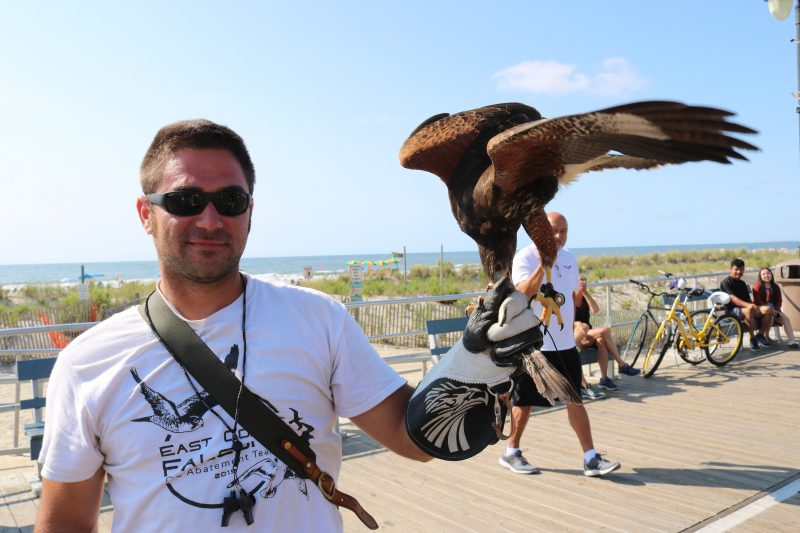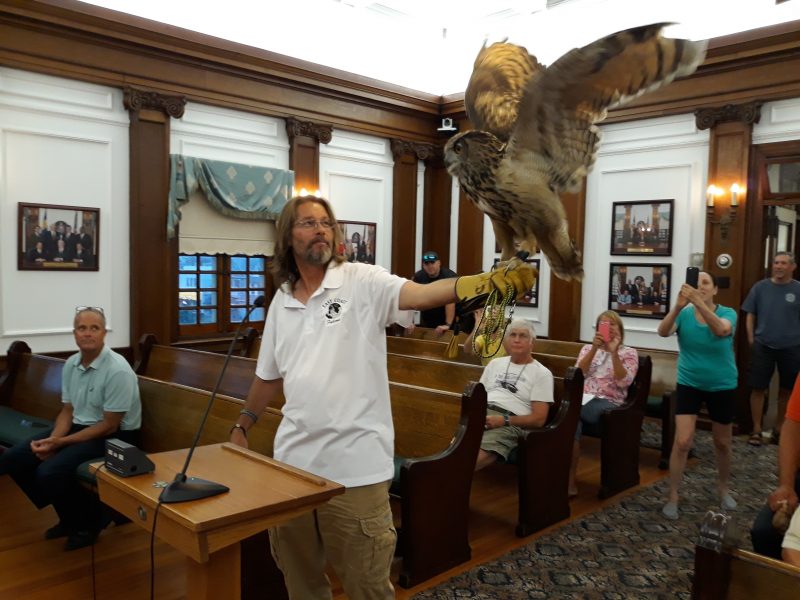Seth Rowe, of East Coast Falcons, handles a hawk named Chip, one of the raptors being used to scare the seagulls.
 By DONALD WITTKOWSKI
Ocean City’s aggressive seagulls were back to their old tricks again earlier this summer – brazenly swooping down to steal a quick meal of French fries, pizza or funnel cakes from unsuspecting tourists.
But that was before the “police” arrived to chase away the pesky birds from the Boardwalk and beaches. Now, the menacing swarms of seagulls have all but disappeared.
“It’s worked out really well. It’s been a big success. I’ve had tons of positive comments,” said Erik Swanson, owner of East Coast Falcons, a company that uses trained raptors to control the gulls.
Swanson loosely describes his group of fierce-looking falcons, hawks and an owl as the police of the skies.
“If you have a hawk or a falcon that’s not out hunting, a seagull is going to ignore it. It’s just like if you have a cop who’s not enforcing the laws. People are going to break the law,” Swanson said.
East Coast Falcons originally had its falcons, hawks and owl patrol the skies above the beaches and Boardwalk during the summer of 2019, the first time Ocean City experimented with trained raptors to harass the seagulls.
Almost immediately, the gulls simply vanished, driven back to the ocean and bays that serve as their natural habitat rather than hanging out in Ocean City’s popular tourist areas to snatch some human food.
The raptors are being used only to scare the gulls, not to kill them.
“We’re not hunting them,” Swanson emphasized. “We don’t want to kill.”
By DONALD WITTKOWSKI
Ocean City’s aggressive seagulls were back to their old tricks again earlier this summer – brazenly swooping down to steal a quick meal of French fries, pizza or funnel cakes from unsuspecting tourists.
But that was before the “police” arrived to chase away the pesky birds from the Boardwalk and beaches. Now, the menacing swarms of seagulls have all but disappeared.
“It’s worked out really well. It’s been a big success. I’ve had tons of positive comments,” said Erik Swanson, owner of East Coast Falcons, a company that uses trained raptors to control the gulls.
Swanson loosely describes his group of fierce-looking falcons, hawks and an owl as the police of the skies.
“If you have a hawk or a falcon that’s not out hunting, a seagull is going to ignore it. It’s just like if you have a cop who’s not enforcing the laws. People are going to break the law,” Swanson said.
East Coast Falcons originally had its falcons, hawks and owl patrol the skies above the beaches and Boardwalk during the summer of 2019, the first time Ocean City experimented with trained raptors to harass the seagulls.
Almost immediately, the gulls simply vanished, driven back to the ocean and bays that serve as their natural habitat rather than hanging out in Ocean City’s popular tourist areas to snatch some human food.
The raptors are being used only to scare the gulls, not to kill them.
“We’re not hunting them,” Swanson emphasized. “We don’t want to kill.”
 East Coast Falcons owner Erik Swanson shows off Ozzy the owl during an appearance at a City Council meeting in 2019.
This summer, another company, Wildlife Control Specialists LLC, of Lebanon, N.J., submitted the lowest bid for the seagull-abatement program and was awarded the contract. The city, though, wasn’t pleased with Wildlife Control Specialists’ performance and decided to switch back to East Coast Falcons, the second-lowest bidder, beginning on July 19.
Swanson said it was “a mess” when his company first returned this summer. Gulls had resumed their nasty habit of harassing the people on the Boardwalk and beaches for their food.
“Either you can control them, or you can’t,” Swanson said matter-of-factly.
He and his employees, along with their raptors, immediately set out to let the gulls know that they were no longer welcomed.
“It’s clean now. There are no gulls,” Swanson said of the dramatic difference since his company took charge in July.
He added, “Some of the things we’ve heard from people are, ‘We’re glad you’re back. We can finally eat on the Boardwalk again.’”
In a statement Tuesday, Ocean City spokesman Doug Bergen noted that Mayor Jay Gillian is happy that East Coast Falcons has returned.
“He said he is pleased with the work East Coast Falcons is doing and glad to see that guests are safe and able to enjoy their time on the Boardwalk,” Bergen said.
East Coast Falcons and the city have agreed that the company will continue operations through Oct. 21 at a daily rate of $1,900. The contract also includes a monthly payment of $3,200 for housing for the company’s employees, according to city documents.
With the peak summer tourism season winding down, Labor Day weekend was the last time East Coast Falcons will have its raptors on patrol seven days a week this year. Now the birds of prey will fly on Fridays, Saturdays and Sundays through Oct. 21.
East Coast Falcons owner Erik Swanson shows off Ozzy the owl during an appearance at a City Council meeting in 2019.
This summer, another company, Wildlife Control Specialists LLC, of Lebanon, N.J., submitted the lowest bid for the seagull-abatement program and was awarded the contract. The city, though, wasn’t pleased with Wildlife Control Specialists’ performance and decided to switch back to East Coast Falcons, the second-lowest bidder, beginning on July 19.
Swanson said it was “a mess” when his company first returned this summer. Gulls had resumed their nasty habit of harassing the people on the Boardwalk and beaches for their food.
“Either you can control them, or you can’t,” Swanson said matter-of-factly.
He and his employees, along with their raptors, immediately set out to let the gulls know that they were no longer welcomed.
“It’s clean now. There are no gulls,” Swanson said of the dramatic difference since his company took charge in July.
He added, “Some of the things we’ve heard from people are, ‘We’re glad you’re back. We can finally eat on the Boardwalk again.’”
In a statement Tuesday, Ocean City spokesman Doug Bergen noted that Mayor Jay Gillian is happy that East Coast Falcons has returned.
“He said he is pleased with the work East Coast Falcons is doing and glad to see that guests are safe and able to enjoy their time on the Boardwalk,” Bergen said.
East Coast Falcons and the city have agreed that the company will continue operations through Oct. 21 at a daily rate of $1,900. The contract also includes a monthly payment of $3,200 for housing for the company’s employees, according to city documents.
With the peak summer tourism season winding down, Labor Day weekend was the last time East Coast Falcons will have its raptors on patrol seven days a week this year. Now the birds of prey will fly on Fridays, Saturdays and Sundays through Oct. 21.
 East Coast Falcons handlers Jack Gilbert, left, and Seth Rowe give people on the Boardwalk a closeup look at Chip the hawk during Labor Day.
This summer brought even more challenges for East Coast Falcons while controlling the gulls. The coronavirus pandemic resulted in more people eating outside, giving seagulls an even greater opportunity to dive-bomb the tourists for their food on the Boardwalk, Swanson noted.
“I think the restaurants were extremely happy that we were getting rid of the gulls,” he said.
Also, Ocean City’s recently completed beach replenishment project stirred up the surf when new sand was being pumped on the shoreline. Another source of seagull food, tiny sea creatures that were churned up during the sand-pumping operations, attracted the birds.
But East Coast Falcons was able to outwit the bird-brained intruders by deploying the raptors in the right way. Swanson said it all came down to making things “scary for the seagulls.”
Swanson and his company have 30 years of experience in chasing away seagulls and other nuisance birds.
“It’s a knack. When you’ve been dealing with it for 30 years, you learn a lot of tricks,” Swanson said.
East Coast Falcons handlers Jack Gilbert, left, and Seth Rowe give people on the Boardwalk a closeup look at Chip the hawk during Labor Day.
This summer brought even more challenges for East Coast Falcons while controlling the gulls. The coronavirus pandemic resulted in more people eating outside, giving seagulls an even greater opportunity to dive-bomb the tourists for their food on the Boardwalk, Swanson noted.
“I think the restaurants were extremely happy that we were getting rid of the gulls,” he said.
Also, Ocean City’s recently completed beach replenishment project stirred up the surf when new sand was being pumped on the shoreline. Another source of seagull food, tiny sea creatures that were churned up during the sand-pumping operations, attracted the birds.
But East Coast Falcons was able to outwit the bird-brained intruders by deploying the raptors in the right way. Swanson said it all came down to making things “scary for the seagulls.”
Swanson and his company have 30 years of experience in chasing away seagulls and other nuisance birds.
“It’s a knack. When you’ve been dealing with it for 30 years, you learn a lot of tricks,” Swanson said.